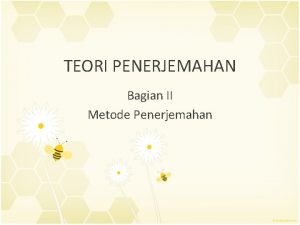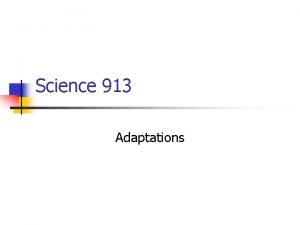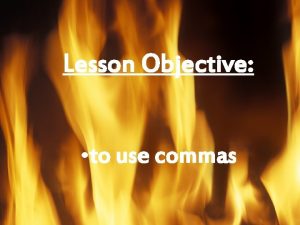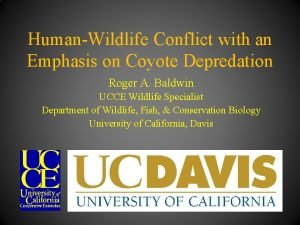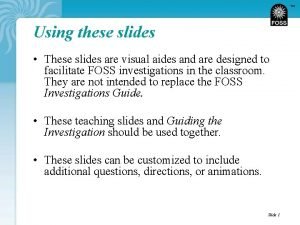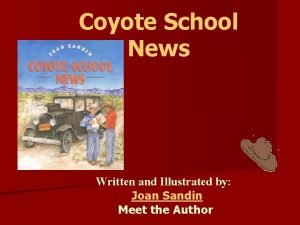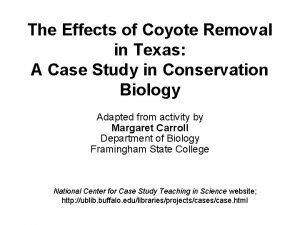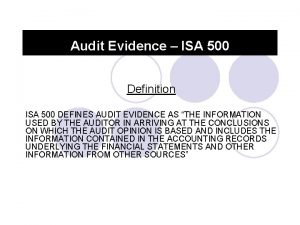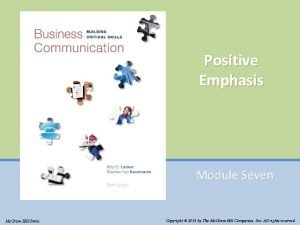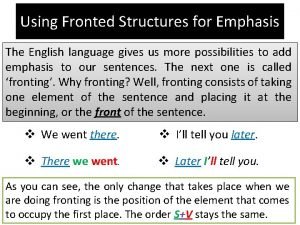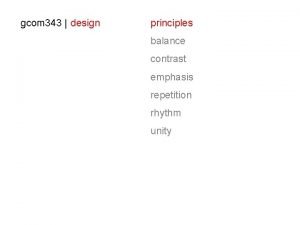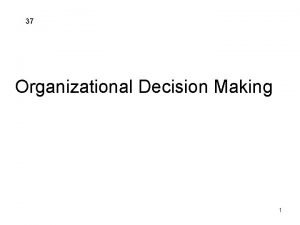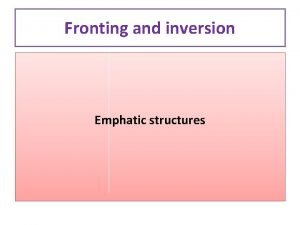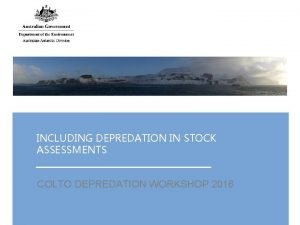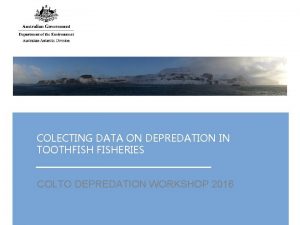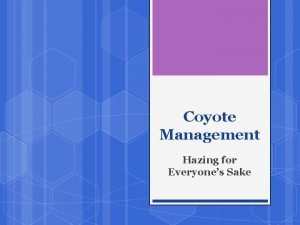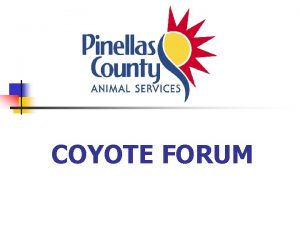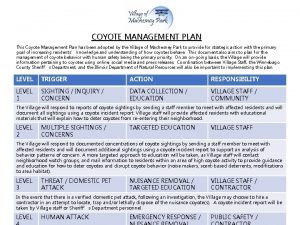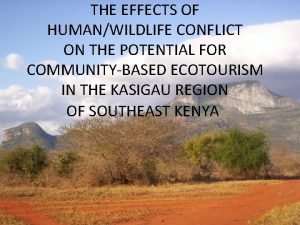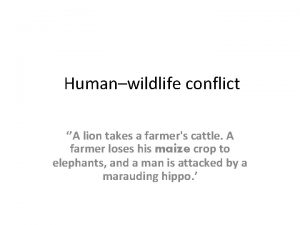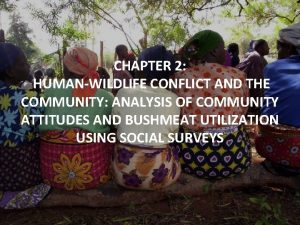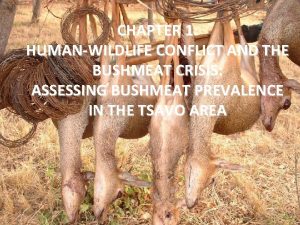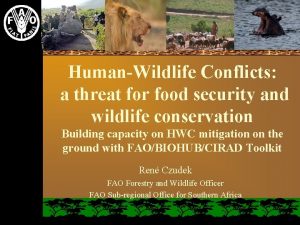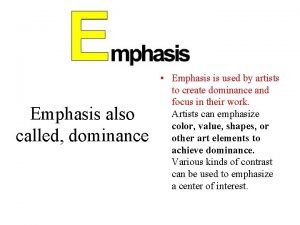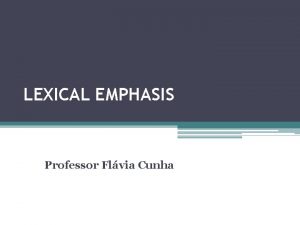HumanWildlife Conflict with an Emphasis on Coyote Depredation










































- Slides: 42

Human-Wildlife Conflict with an Emphasis on Coyote Depredation Roger A. Baldwin UCCE Wildlife Specialist Department of Wildlife, Fish, & Conservation Biology University of California, Davis

Benefits of Wildlife • Physical utility • Monetary • Recreational • Scientific • Ecological • Existence Adapted from Conover 2002

What Are Vertebrate Pests? • Nonhuman species of vertebrate animals that are currently troublesome locally, or over a wide area, to one or more persons, either by being a health hazard, a general nuisance, or by destroying food, fiber, or natural resources.

What is Human-Wildlife Conflict? • The negative interaction of humans and other vertebrate animals. • Such situations could result in: - health hazards

What is Human-Wildlife Conflict? • The negative interaction of humans and other vertebrate animals. • Such situations could result in: - health hazards - destruction of food, fiber, or natural resources.

What is Human-Wildlife Conflict? • The negative interaction of humans and other vertebrate animals. • Such situations could result in: - health hazards - destruction of food, fiber, or natural resources. - general nuisance incidents

History • Human-wildlife conflict has always been present. • Really came to the forefront in western U. S. with an increase in livestock production and agriculture.

Livestock Issues • Pioneers concerned about losses of livestock to predators. • Much effort was taken to reduce or eliminate predator populations.

Livestock Damage Estimates • In 2010, predators resulted in loss of 220, 000 head of livestock. • This totaled $98. 5 million in losses to ranchers. • Does not account for indirect losses (e. g. , weaning weights of calves 2 -10% lower in presence of wolves). • $188. 5 million was expended for non-lethal control of predators.

Current Control Strategies • Currently, we focus on an integrated approach that utilizes a number of strategies and tools to control vertebrate pests.

Current Control Strategies • Currently, we focus on an integrated approach that utilizes a number of strategies and tools to control vertebrate pests.

Management Options • Two-tiered system: – Nonlethal options – Lethal options

Management Options • Two-tiered system: – Nonlethal options – Lethal options • Nonlethal control is principle focus

Management Options • Two-tiered system: – Nonlethal options – Lethal options • Nonlethal control is principle focus • Lethal options used when needed

Management Options—Nonlethal • Habitat modification – Certain habitats are more conducive to depredation events. • Pasturing, lambing, & calving habitat – Pasture in areas with less history of depredation. – Shortening birthing period can overwhelm predators. – Particularly avoid these areas at sensitive times. – Could graze cattle in heavy coyote depredation areas.

Management Options—Nonlethal • Sanitation – Removing carcasses may lessen depredation pressure. – Less feasible over large areas.

Management Options—Nonlethal 1. Woven wire fence

Management Options—Nonlethal 1. Woven wire fence 2. Electric fence

Management Options—Nonlethal 1. Woven wire fence 2. Electric fence 3. Combination fence

Management Options—Nonlethal 1. Woven wire fence 2. Electric fence 3. Combination fence 4. Portable electric fence

Management Options—Nonlethal • Night/seasonal enclosure – – Predation greatest at night. Bring livestock into enclosures at night can reduce threat. Calving and lambing in such areas also reduces threat. Not as plausible over large areas.

Management Options—Nonlethal • Herding – Constant human presence is effective. – Allows behavioral observation. – Expensive. – Limited qualified labor force. • Disruptive harassment – Running off or shooting with rubber slugs or paint balls

Management Options—Nonlethal • Guard dogs – Can effectively reduce livestock losses from coyotes. – Require extensive training. – Can be expensive. – May directly predate on livestock.

Management Options—Nonlethal • Guard dogs – Can effectively reduce livestock losses from coyotes. – Require extensive training. – Can be expensive. – May directly predate on livestock. • Donkeys/llamas – – Can also reduce livestock losses. Less training/greater longevity. Less specialized care. Less concern with other coyote management options.

Management Options—Nonlethal • Visual frightening approaches – Lights around pens and corrals somewhat effective. – Vehicles left in area somewhat effective, especially if moved. – Coyotes will habituate quickly.

Management Options—Nonlethal • Visual frightening approaches – Lights around pens and corrals somewhat effective. – Vehicles left in area somewhat effective, especially if moved. – Coyotes will habituate quickly. • Auditory frightening devices – Radios in animal holding areas. – Propane cannons and sirens. – Combinations can be most effective (e. g. , Electronic Guards). – More effective when triggered. – Can be irritant to neighbors and efficacy is not long term.

Management Options—Nonlethal • Fladry – – Strands of flags strung just above ground. Can keep canids out for a couple of months. Turbo fladry is often more effective. Best if used as one part of management program.

Management Options—Lethal • Broad-scale population reduction – – – Goal is to minimize population density over a broad area. Can reduce depredation events if intensive enough. Must be repeated over time to keep populations from rebounding. Is expensive. Can alter population demographics. May impact nontarget species.

Management Options—Lethal • Broad-scale population reduction – Historical options included: Ø Ø Ø bounties trapping (including leg-hold traps) shooting (including aerial gunning)

Management Options—Lethal • Broad-scale population reduction – Historical options included: Ø Ø Ø bounties trapping (including leg-hold traps) shooting (including aerial gunning) – Current options include: Ø Ø snaring shooting (lead bullet ban may limit) – Not widely used in CA today.

Management Options—Lethal • Targeted removal – Goal is to remove offending individuals. Ø Ø alpha pairs often responsible coyotes with pups increase problems – Is less expensive. – Should have little impact on nontarget species. – More common approach used today.

Management Options—Lethal • Targeted removal – Snares

Management Options—Lethal • Targeted removal – Snares – Calling and shooting

Management Options—Lethal • Targeted removal – Snares – Calling and shooting – Livestock protection collars no longer used in CA

Management Options—Lethal • Targeted removal – Den site (Wildlife Services only) Ø Ø pup removal reduces depredations gas cartridges

Management Options—Lethal • Targeted removal – Den site (Wildlife Services only) Ø Ø pup removal reduces depredations gas cartridges – Removal over sensitive area Ø Ø targeted for short period/small area can be preventative or reactive

Management Options—Impacts • Fencing – Can alter wildlife movement. – Can cause range degradation. • Guard dogs – Can harass wildlife. • Snares – If used incorrectly, could result in nontarget take.

Management Options—Example • Integrated approach – Fladry to deter. Scary!

Management Options—Example • Integrated approach – Fladry to deter. – Guard animals to reinforce deterrent. Maybe not…

Management Options—Example • Integrated approach – Fladry to deter. – Guard animals to reinforce deterrent. – Lethal removal when other options fail.

Summary • Coyotes and other predators are a valuable part of the environment and often cause little damage. • When damage occurs, nonlethal approaches are preferred. • Lethal control will be needed in some situations. • The integration of a variety of control methods will provide the best results and have the least impact on the natural ecosystem.

Thanks!
 Contoh metode penerjemahan adaptasi
Contoh metode penerjemahan adaptasi Cougar structural adaptations
Cougar structural adaptations Coyote and the buffalo text analysis answers
Coyote and the buffalo text analysis answers Canada goose coyote farm
Canada goose coyote farm Coyote brings fire answer key
Coyote brings fire answer key Food web energy pyramid
Food web energy pyramid Coyote stories mourning dove
Coyote stories mourning dove Coyote finishes his work theme
Coyote finishes his work theme Fox and coyote and whale
Fox and coyote and whale Can wile e coyote talk
Can wile e coyote talk Coyote roundup snare
Coyote roundup snare The sky tree summary
The sky tree summary Characteristics of food web
Characteristics of food web Panda poem
Panda poem Coyote school news summary
Coyote school news summary Chaparral climatogram
Chaparral climatogram Coyote finishes his work answers
Coyote finishes his work answers Coyote removal case study answers
Coyote removal case study answers Internal and external conflict worksheet
Internal and external conflict worksheet What is conflict and conflict resolution?
What is conflict and conflict resolution? Internal conflict and external conflict definition
Internal conflict and external conflict definition Educational emphasis
Educational emphasis Emphasis center of interest
Emphasis center of interest The actual surface feel of the simulated appearance
The actual surface feel of the simulated appearance Contract synoynm
Contract synoynm Emphasis of matter going concern example
Emphasis of matter going concern example Emphasis
Emphasis Positive emphasis
Positive emphasis Life-situation design
Life-situation design Psp in software engineering
Psp in software engineering Areas of special emphasis examples
Areas of special emphasis examples Exploratory and descriptive research design slideshare
Exploratory and descriptive research design slideshare Focal point placement
Focal point placement Cleft sentences это
Cleft sentences это Society where emphasis shifts from production
Society where emphasis shifts from production Paragraph unity and coherence
Paragraph unity and coherence Balance is to even distribution; emphasis is to
Balance is to even distribution; emphasis is to In which emphasis is on advertisement
In which emphasis is on advertisement Incremental model of decision making
Incremental model of decision making Emphatic structure
Emphatic structure Rorschach card 10
Rorschach card 10 You put the wrong emphasis on the wrong syllable
You put the wrong emphasis on the wrong syllable Fixation omission emphasis
Fixation omission emphasis
